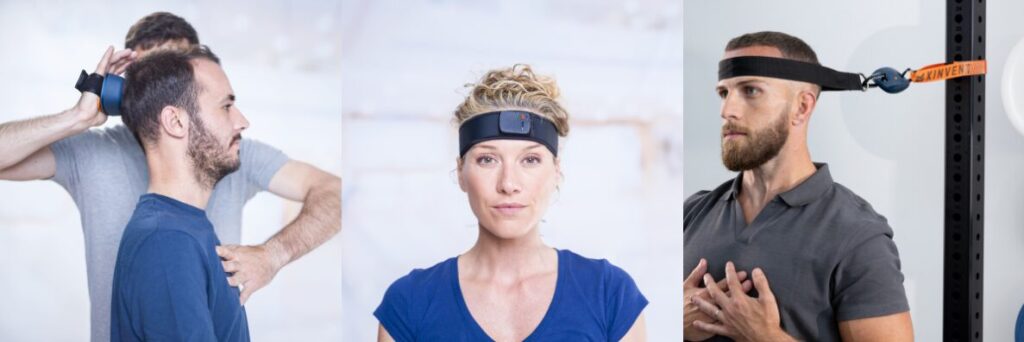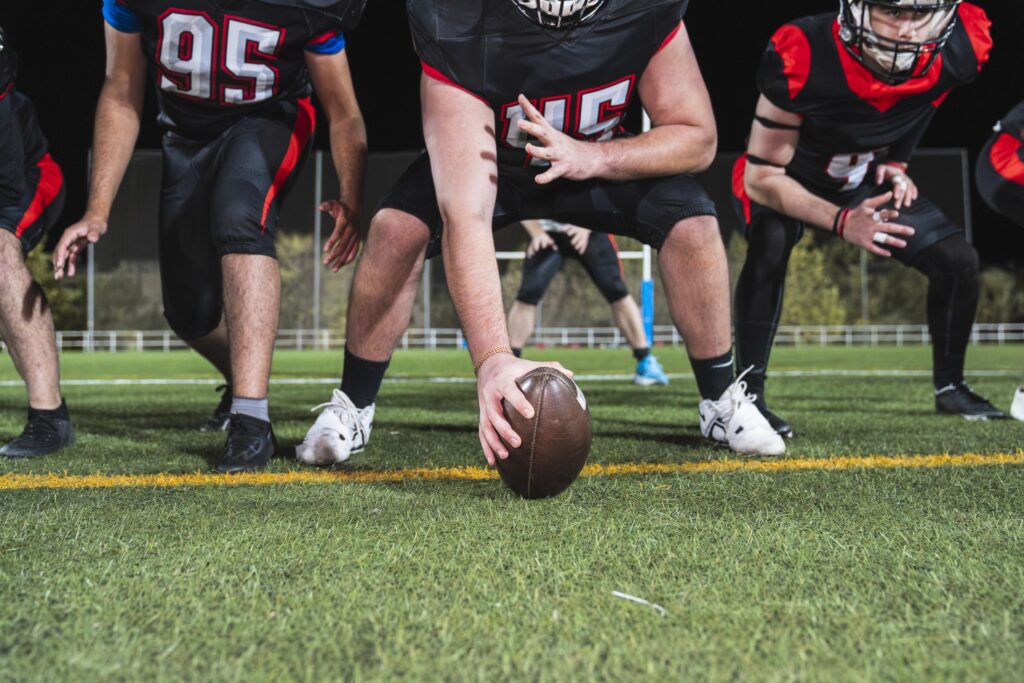Neck training for concussion prevention is emerging as a key strategy to protect athletes in contact and collision sports. Concussions are among the biggest concerns in American football, hockey, soccer, Formula 1, and combat sports, where players are frequently exposed to head acceleration events (HAEs), sudden head movements caused by impacts that can increase the risk of brain injury.
Growing evidence suggests that strengthening the neck can improve stability, help athletes brace for impact, and lower the magnitude of HAEs. A recent systematic review and Delphi consensus study published in the British Journal of Sports Medicine (Fownes-Walpole et al., 2025) combined current evidence with expert recommendations to define best practices for neck training.
In this article, we’ll explain what HAEs are, review the latest scientific findings, highlight the expert consensus, and provide practical strategies for integrating neck training into sports performance and injury prevention programs.
CONTENTS
1- What are Head Acceleration Events (HAEs)?
2- What does Science say about Neck Training?
3- Expert Consensus on Neck Training (Delphi Study)
4- Practical Principles of Neck Training
5- Neck Exercises for Concussion Prevention
6- Focus on Youth Athletes and Professional Sports
7- FAQ: Neck Training and Concussion Prevention
8- Key Takeaways
9- Conclusion & Perspectives
10- Reference
1- What are Head Acceleration Events (HAEs)?
Head acceleration events (HAEs) occur when an external force, such as a tackle, punch, or collision, suddenly moves an athlete’s head. These rapid accelerations can be direct (from an impact to the head) or indirect (force transmitted through the body to the head). Both can place significant stress on the brain inside the skull.
HAEs are common in contact and collision sports such as rugby, American football, hockey, boxing, martial arts, and even motor sports. Unlike a single major concussion, HAEs can also include repeated sub-concussive impacts, smaller hits that may not cause immediate symptoms but can still accumulate and affect long-term brain health.
Research shows that reducing the magnitude and frequency of HAEs is critical for protecting athletes. This is where neck training for concussion prevention comes into play: a stronger, more stable neck can limit excessive head movement during impact, acting as a natural shock absorber.
2- What does Science Say about Neck Training?
The relationship between neck training and concussion prevention has been widely discussed, but what does the evidence actually show?
A recent systematic review of 21 studies (Fownes-Walpole et al., 2025, British Journal of Sports Medicine) examined the effect of neck strengthening programs on head acceleration events (HAEs) in sports.
The findings were clear but nuanced:
- Scientific evidence is limited and heterogeneous. The studies varied in design, training methods, and outcomes, which makes it difficult to draw definitive conclusions.
- Neck strength matters. Across multiple studies, athletes with stronger necks experienced lower head accelerations during impacts.
- Muscle pre-activation is key. Preparing and bracing the neck muscles before contact, such as anticipating a tackle, can further reduce head movement.
- Evidence quality is low, but trends are positive. Most studies have shown improvements in neck strength, and some have demonstrated reductions in head acceleration. However, the results are not yet consistent across all sports and populations.
In short, while more high-quality, long-term studies are needed, the current body of research suggests that building neck strength can reduce HAEs and may help lower concussion risk.
💡 Want to go deeper into the science and practice of neck training for concussion prevention? Don’t miss our exclusive webinar replay, “Screening and Assessment of Concussed Athletes Using the Latest Technology.”
Hosted by physical therapists Nick Schuster and Dr. Felix Leung, this session explores how cutting-edge technology and evidence-based practices are transforming concussion screening, rehabilitation, and prevention.
3- Expert Consensus on Neck Training (Delphi Study)
Because the scientific evidence alone is not yet strong enough, researchers turned to expert consensus to define best practices for neck training. Using the Delphi method, an international panel of 18 experts, including sports scientists, strength and conditioning coaches, physical therapists, and physicians, reached agreement on 57 recommendations for implementing neck training in sports.
Here are the key takeaways:
- Neck training should be included in concussion prevention programs. Even if the evidence is still limited, experts agree that it is a valuable protective strategy in contact and collision sports.
- Train in all planes of movement. Programs should target flexion, extension, lateral flexion, and rotation to build balanced neck strength.
- Use multiple contraction types. A combination of isometric, concentric, eccentric, and motor control exercises is recommended.
- Integrate into full-body training. Neck training should not be isolated; it works best when included in overall strength and conditioning routines.
- Adapt to the athlete’s context. Programs should be tailored to the athlete’s age, sex, playing level, and sport demands.
- Measure and monitor. Regular testing of neck strength and endurance helps track progress and guide load adjustments.
This Delphi consensus on neck training bridges the gap between limited scientific studies and applied practice. It provides coaches, physical therapists, and sports organizations with a clear, evidence-informed framework to systematically implement neck training for concussion prevention.
4- Practical Principles of Neck Training
Turning research and expert consensus into action requires simple, structured, and adaptable training methods. Here are the practical guidelines for implementing neck training for concussion prevention:
Training frequency
2-3 sessions per week are recommended, ideally integrated into regular strength and conditioning programs.
Progression
- Start with isometric holds (pushing against resistance without moving the head).
- Progress to dynamic exercises with resistance (bands, partner drills, weighted harness).
- Incorporate eccentric and concentric work to build resilience across all contraction types.
Multi-planar approach
- Train the neck in all directions: flexion (forward), extension (backward), lateral flexion (side-to-side), and rotation (left-right).
- This ensures balanced strength and reduces the risk of muscular imbalances.
Endurance and speed
- Include exercises targeting endurance (longer holds, higher repetitions).
- Develop rate of force development (RFD) to enhance impact anticipation and muscle pre-activation before collisions.
- Develop reactivity and proprioception by adding exercises that stimulate dual tasks and/or eye tracking, movement in space, etc.
Minimal equipment, maximum impact
- Effective neck training exercises for athletes can be done with simple tools such as resistance bands, a ball, harnesses, or partner-applied resistance.
- This makes it accessible for both professional and amateur settings.
Monitoring and evaluation
- Regular testing of neck strength and endurance helps tailor programs to each athlete.
- Monitoring the flexor/extensor ratio can highlight risk factors (e.g., rugby players with weak flexors are more prone to concussions).
💡 Effective neck training for concussion prevention relies not only on good exercise selection but also on accurate testing and monitoring. This is where technology can make a difference.

- With K-Move, coaches and physical therapists can assess and track cervical spine mobility across all planes: flexion, extension, lateral flexion, and rotation. This helps identify restrictions, monitor progress, and personalize mobility drills.
- Tools like K-Pull and K-Push provide objective data for both the assessment and training of cervical muscles. They allow precise measurement of flexors, extensors, and lateral stabilizers, ensuring balanced development and helping detect potential weak points.
In the Kinvent app, two endurance tests complete the cervical function assessment:
- Cervical extensor endurance test: assesses the ability of the cervical extensor muscles to maintain prolonged isometric contraction. This test is particularly relevant for athletes exposed to repeated impacts, as well as for people suffering from neck pain or postural disorders.
- Deep neck flexor endurance test: measures the endurance of the deep neck flexors, particularly the long neck and long head muscles. These muscles are essential for ensuring the stability and posture of the cervical spine, playing a key role in preventing imbalances and injuries.
These assessments, integrated directly into the Kinvent app, enable objective and individualized monitoring of cervical endurance, facilitating the customization of concussion prevention programs.

By integrating these devices into regular programs, practitioners move from subjective impressions to a data-driven approach, making neck training more effective, personalized, and measurable.
5- Neck Exercises for Concussion Prevention
Building a strong and stable neck doesn’t require complex equipment. The following neck exercises for concussion prevention, recommended by experts and supported by consensus guidelines, can be adapted to athletes of all levels:
Isometric holds
- How to do it: Push your head gently against resistance (hand, band, or partner) without moving.
- Benefit: Improves static stability and prepares the muscles to absorb impact.
- Example: Front, back, and side isometric holds (10–15 seconds each, repeat 3–5 times).
Resistance band flexion & extension
- How to do it: Attach a band behind or in front of the head and move slowly forward (flexion) or backward (extension).
- Benefit: Builds dynamic strength in sagittal planes.
- Tip: Start with light resistance and progress gradually.
Lateral flexion (Side-to-Side)
- How to do it: Use a band, harness, or partner to resist sideways tilts of the head.
- Benefit: Strengthens lateral stabilizers, important in contact sports like rugby and football.
Rotational strength
- How to do it: Rotate the head left and right against resistance.
- Benefit: Improves neck control in the transverse plane, critical for combat sports and heading sports.
Endurance circuits
- How to do it: Combine isometric holds and light dynamic reps for longer sets (30–60 seconds).
- Benefit: Enhances muscle endurance and resilience during repeated impacts.
⚠️ It is essential to maintain proper alignment of the cervical and spinal column, ensuring good posture throughout all resistance exercises.
6- Focus on Youth Athletes and Professional Sports
Why Neck Training Matters for Young Athletes?
Youth athletes are particularly vulnerable to head acceleration events (HAEs) because their neck muscles are less developed than those of adults. In contact sports like rugby, football, and hockey, this means they have a reduced ability to stabilize the head during impacts.
- Early intervention is key. Introducing structured neck training in youth programs can build resilience before athletes reach higher levels of competition.
- Accessibility matters. Since equipment should remain simple (bands, partner drills), even grassroots clubs can implement these programs effectively.
Neck Training in Elite and Professional Sports
At the professional level, the stakes are even higher. Concussions can sideline athletes, impact careers, and raise long-term health concerns. This is why neck strengthening in professional sports is already a priority:
- The NFL Head, Neck & Spine Committee focuses on head, neck, and cervical spine injuries, developing research-based prevention protocols to improve neck stability and reduce concussion risks across American football.
- The UFC Performance Institute has developed a “Neck Strengthening Matrix” for combat athletes. This is a structured framework that categorizes neck exercises and training prescriptions according to the specific type of strength expression required.
Bridging Science and Practice with Technology
Despite limited high-quality evidence, the expert consensus is clear: neck training should be systematically included in performance and injury-prevention programs across all levels. What differs is the intensity, progressivity, and monitoring based on age, sex, and sport demands.
💡 Applied example: In both youth academies and professional clubs, using Kinvent’s ecosystem (K-Push, K-Pull, K-Move, and Kinvent app) allows coaches and physical therapists to:
- Measure and monitor neck strength objectively.
- Track development in young athletes over seasons.
- Personalize training loads for professional athletes in collision sports.
This combination of scientific evidence, expert consensus, and modern technology makes neck training for concussion prevention more effective, measurable, and adaptable across all levels of sport.
7- FAQ: Neck Training and Concussion Prevention
Does neck training really prevent concussions?
Current evidence is limited, but research suggests that stronger neck muscles can reduce head acceleration events (HAEs), which are linked to concussions. While neck training doesn’t guarantee prevention, it is considered a valuable protective factor in contact sports.
How often should athletes train their neck?
Experts recommend 2–3 sessions per week, integrated into regular strength and conditioning programs. The key is to combine isometric, concentric, eccentric, and motor control exercises across all planes of motion.
Do youth athletes need neck training?
Yes. Young athletes are especially vulnerable because their neck muscles are not fully developed. Structured, age-appropriate neck training can improve stability and reduce concussion risk as they progress in competitive sports.
What equipment is needed for neck strengthening?
Neck training can be done with minimal equipment, such as resistance bands, harnesses, or partner resistance. For objective measurement and monitoring, devices like the K-Push, K-Pull, or K-Move from Kinvent can provide reliable data on strength and progress.
What are isometric neck exercises?
Isometric neck exercises are strength-training movements where the neck muscles contract without any visible movement of the head or neck. These exercises involve pushing or holding the head against a stable resistance, such as a hand or a wall, to build muscle strength, stability, and endurance. They are often used in rehabilitation, posture improvement, and injury prevention because they strengthen the neck safely without putting excessive strain on the cervical spine.
8- Key Takeaways
- Head acceleration events (HAEs) are a major risk factor for concussions and long-term brain health issues in contact and collision sports.
- Neck training for concussion prevention is supported by growing evidence: stronger and more reactive neck muscles can reduce head accelerations.
- A recent systematic review and Delphi consensus study (Fownes-Walpole et al., 2025, British Journal of Sports Medicine) recommends systematic inclusion of neck strengthening in sports programs.
- Effective training should be multi-planar, combining isometric, concentric, eccentric, and motor control exercises.
- 2–3 sessions per week with progressive overload are ideal, and only minimal equipment is needed.
- Monitoring matters: tracking strength, endurance, and flexor/extensor ratios helps personalize programs.
- Applicable for both youth athletes (to build resilience early) and professionals (to reduce concussion risks at the highest level).
9- Conclusion & Perspectives
Concussions will likely remain a challenge in sports, but evidence suggests that neck training offers a simple, low-cost, and effective strategy to reduce head acceleration events (HAEs). While current studies show promising results, more high-quality, long-term research is needed to fully establish its impact on concussion rates.
The expert consensus is clear: cervical strengthening should be systematically included in training routines for athletes in contact and collision sports. From grassroots clubs to professional organizations, integrating neck exercises can play a vital role in concussion prevention and overall athlete safety.
With the support of modern solutions like Kinvent’s K-Move, K-Push, and K-Pull, practitioners can shift from guesswork to data-driven, personalized neck training strategies that improve both athlete safety and performance.
For physical therapists, coaches, and sports organizations, the message is clear: make neck strengthening a cornerstone of concussion prevention. Protecting the brain starts with building a stronger neck.
10- Reference
Collins, C. L., Fletcher, E. N., Fields, S. K., Klusman, J. K., Smith, G. A., & Comstock, R. D. (2014). Neck strength: a protective factor against concussion in high school sports. Journal of Sport and Exercise Psychology, 36(2), 173–181. DOI: 10.1007/s10935-014-0355-2
Daly, E., Pearce, A. J., & Ryan, L. (2021). Neck strength and conditioning protocols: a review of the literature for concussion prevention. Journal of Functional Morphology and Kinesiology, 6(1), 8. DOI: 10.3390/jfmk6010008
Elliott, J., Alsayed, K. E., Taha, M. S., & Papi, E. (2021). Is neck strengthening an effective strategy to reduce the incidence of head and neck injuries in sport? A systematic review. Sports Medicine, 51(12), 2639–2655. DOI: 10.1007/s40279-021-01501-1
Fownes-Walpole, M., Berran, M., O’Halloran, P., et al. (2025). Consensus statement on optimal neck training protocols for sports and rehabilitation: A Delphi study. British Journal of Sports Medicine, 59(Suppl 1), A1–A10.
Garrett, J. M., Kim, S. W., Suter, B. C., & D’Loff, L. A. (2023). The relationship between neck strength and sports-related concussion: A systematic review with meta-analysis. Journal of Orthopaedic & Sports Physical Therapy, 53(10), 629–642. DOI: 10.2519/jospt.2023.11727
Haider, M. N., O’Brien, P., & Meehan, W. P. (2020). Cervical and vestibular rehabilitation in sport-related concussion: a systematic review. PM&R, 12(12), 1184–1193. DOI: 10.1002/pmrj.12366
Leung, F. T., Smith, A., Jones, P., & Davies, B. (2025). Neck strength deficit is a risk factor for concussion in high school athletes. BMJ Open Sport & Exercise Medicine, 11(1), e001111.
Lin, C. L., Chen, K. H., & Chou, P. H. (2024). Examining the role of neck strength in modifying the acute cognitive effects of soccer heading: a longitudinal study. PLoS ONE, 19(4), e0302463. DOI: 10.1371/journal.pone.0302463
Petrie, F. J., O’Driscoll, A., & Walsh, J. (2024). Effects of an 8-week neck strengthening and proprioception program on strength and feasibility in female rugby players: a pilot study. Physical Therapy in Sport, 65, 1–7. PubMed ID: 39817645.
Tierney, R. T., Mattacola, C. G., & Hurd, W. J. (2005). Cervical spine stabilization and head/neck kinematic response to impulsive forces in college-aged male and female athletes. Medicine and Science in Sports and Exercise, 37(2), 235–242. DOI: 10.1249/01.mss.0000152734.47516.aa
Waring, K. M., Feller, J. A., & Stuelcken, M. S. (2022). Effect of a 6-week neck strengthening program on soccer heading biomechanics and cognition: a randomized controlled trial. Physical Therapy in Sport, 55, 1–8. DOI: 10.26603/001c.38327
